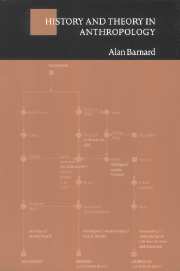Book contents
- Frontmatter
- Contents
- List of figures
- List of tables
- Preface
- 1 Visions of anthropology
- 2 Precursors of the anthropological tradition
- 3 Changing perspectives on evolution
- 4 Diffusionist and culture-area theories
- 5 Functionalism and structural-functionalism
- 6 Action-centred, processual, and Marxist perspectives
- 7 From relativism to cognitive science
- 8 Structuralism, from linguistics to anthropology
- 9 Poststructuralists, feminists, and (other) mavericks
- 10 Interpretive and postmodernist approaches
- 11 Conclusions
- Appendix 1 Dates of birth and death of individuals mentioned in the text
- Appendix 2 Glossary
- References
- Index
5 - Functionalism and structural-functionalism
- Frontmatter
- Contents
- List of figures
- List of tables
- Preface
- 1 Visions of anthropology
- 2 Precursors of the anthropological tradition
- 3 Changing perspectives on evolution
- 4 Diffusionist and culture-area theories
- 5 Functionalism and structural-functionalism
- 6 Action-centred, processual, and Marxist perspectives
- 7 From relativism to cognitive science
- 8 Structuralism, from linguistics to anthropology
- 9 Poststructuralists, feminists, and (other) mavericks
- 10 Interpretive and postmodernist approaches
- 11 Conclusions
- Appendix 1 Dates of birth and death of individuals mentioned in the text
- Appendix 2 Glossary
- References
- Index
Summary
The terms ‘functionalist’ and ‘structural-functionalist’ and their corresponding ‘isms’ are now quite stable in their meanings. However, this was not always the case. Before looking at the theories, a brief tour of the changing nuances of the terms is in order.
‘Functionalism’ is a broad term. In its widest sense, it includes both functionalism (narrowly defined) and structural-functionalism. I use it mainly in the narrower sense, that is, to refer to ideas associated with Bronislaw Malinowski and his followers, notably Sir Raymond Firth. It is the perspective concerned with actions among individuals, the constraints imposed by social institutions on individuals, and relations between the needs of an individual and the satisfaction of those needs through cultural and social frameworks. ‘Structural-functionalism’ tends to be concerned less with individual action or needs, and more with the place of individuals in the social order, or indeed with the construction of the social order itself. Typically, the latter term identifies the work of A. R. Radcliffe-Brown and his followers. In Britain these included E. E. Evans-Pritchard (in his early work), Isaac Schapera, Meyer Fortes, and Jack Goody, among many others.
Yet the boundary between structural-functionalism and functionalism was never rigid. Some of Radcliffe-Brown's followers did not mind the term ‘functionalist’; others took to the labels ‘structural-functionalist’ or ‘structuralist’ (to distinguish their work from that of Malinowski). Furthermore, the term ‘British structuralist’ was heard in the 1950s to distinguish Radcliffe-Brownianism from Lévi-Straussianism or ‘French structuralism’ (described in chapter 8).
Information
- Type
- Chapter
- Information
- History and Theory in Anthropology , pp. 61 - 79Publisher: Cambridge University PressPrint publication year: 2000
Accessibility standard: Unknown
Why this information is here
This section outlines the accessibility features of this content - including support for screen readers, full keyboard navigation and high-contrast display options. This may not be relevant for you.Accessibility Information
- 1
- Cited by
